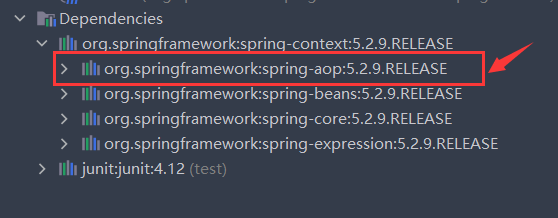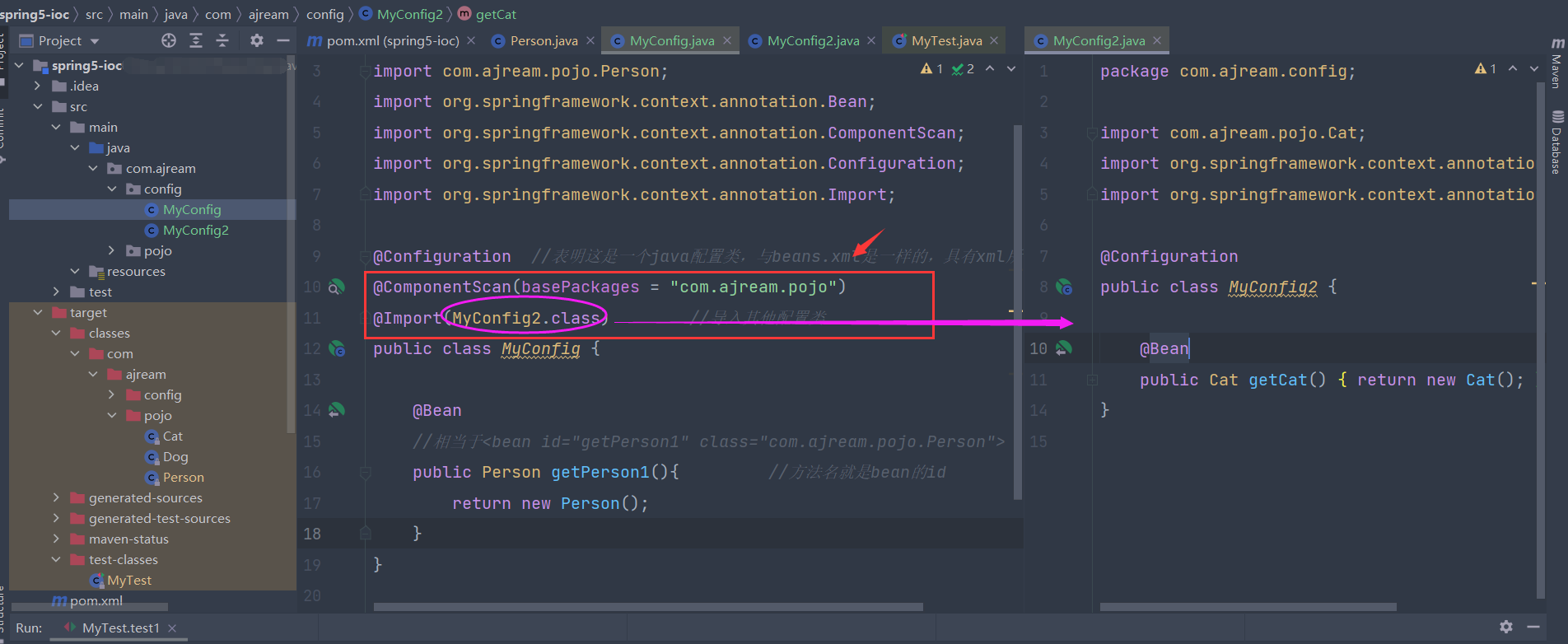10-使用注解开发
使用注解开发
依然使用xml配置文件来管理
spring4之后,要使用注解开发,必须保证aop的包导入了

使用注解开发,要导入context约束,提供注解的支持
<?xml version="1.0" encoding="UTF-8"?>
<beans xmlns="http://www.springframework.org/schema/beans"
xmlns:xsi="http://www.w3.org/2001/XMLSchema-instance"
xmlns:context="http://www.springframework.org/schema/context"
xsi:schemaLocation="http://www.springframework.org/schema/beans
https://www.springframework.org/schema/beans/spring-beans.xsd
http://www.springframework.org/schema/context
https://www.springframework.org/schema/context/spring-context.xsd">
<context:annotation-config/>
<!-- 指定要扫描的包,即在该包下的注解生效-->
<context:component-scan base-package="com.ajream.pojo"/>
</beans>
-
bean
@component: //组件,在创建的类前面加上这个注解,说明这个类已经被spring管理了,相当于: //<bean id="person" class="com.ajream.pojo.Person"> //没有参数时,只能以getBean("类名的小写字母") 来获取bean @component(value="xxx") //有参数时,可以用getBean("xxx") 来获取beanPerson类:
package com.ajream.pojo; import org.springframework.stereotype.Component; @Component //没有参数时,只能以getBean("person") 来获取bean public class Person { public String name = "张三"; } -
属性注入
@Value("李四"): //相当于<property name="name" value="李四" /> </code></pre> <pre><code>@Component public class Person { @Value("李四") //注入属性值 public String name; }也可以在setter方法前使用:
@Component public class Person { public String name; @Value("李四") public void setName(String name) { this.name = name; } } -
衍生注解
@Component有几个衍生注解,在web中一般按照mvc三层架构划分:
- dao层:@Repository
- service层:@Service
- Controller层:@Controller
这4个注解功能一样的
-
作用域scope
单例
@Component @Scope(value = "singleton") public class Person { public String name; @Value("李四") public void setName(String name) { this.name = name; } }原型
@Scope(value = "prototype")小结:
xml与注解- xml:万能
- 注解:不是自己的类用不了,维护相对复杂
xml与注解最佳实践:
-
xml用来管理bean
-
注解只负责属性注入
注意:要让注解生效,必须开启注解的支持
<context:annotation-config/> <context:component-scan base-package="com.ajream.pojo"/>
使用Java的方式配置spring
在此前一直都使用beans.xml配置文件来配置spring如属性注入,现在可以不使用xml了,将spring配置全权交由Java来配置
用MyConfig类来代替beans.xml:
package com.ajream.config;
import com.ajream.pojo.Person;
import org.springframework.context.annotation.Bean;
import org.springframework.context.annotation.Configuration;
@Configuration
public class MyConfig {
@Bean
//相当于<bean id="getPerson1" class="com.ajream.pojo.Person">
public Person getPerson1(){ //方法名就是bean的id
return new Person();
}
}
Person类:
package com.ajream.pojo;
import org.springframework.beans.factory.annotation.Value;
public class Person {
public String name;
@Value("李四")
public void setName(String name) {
this.name = name;
}
public String getName() {
return name;
}
}
MyTest类

这里不使用xml配置文件了,使用Java配置类 MyConfig
import com.ajream.config.MyConfig;
import com.ajream.pojo.Person;
import org.junit.Test;
import org.springframework.context.ApplicationContext;
import org.springframework.context.annotation.AnnotationConfigApplicationContext;
public class MyTest {
@Test
public void test1() {
//加载配置类
ApplicationContext context = new AnnotationConfigApplicationContext(MyConfig.class);
Person p = context.getBean("getPerson1", Person.class);
System.out.println(p.getName());
}
}
@Test
public void test1() {
//加载配置类
ApplicationContext context = new AnnotationConfigApplicationContext(MyConfig.class);
Person p = context.getBean("getPerson1", Person.class);
System.out.println(p.getName());
}
由于MyConfig类也是配置类,所以它具有beans.xml的功能,比如:

本文来自博客园,作者:aJream,转载请记得标明出处:https://www.cnblogs.com/ajream/p/15383520.html



【推荐】国内首个AI IDE,深度理解中文开发场景,立即下载体验Trae
【推荐】编程新体验,更懂你的AI,立即体验豆包MarsCode编程助手
【推荐】抖音旗下AI助手豆包,你的智能百科全书,全免费不限次数
【推荐】轻量又高性能的 SSH 工具 IShell:AI 加持,快人一步
· AI与.NET技术实操系列:向量存储与相似性搜索在 .NET 中的实现
· 基于Microsoft.Extensions.AI核心库实现RAG应用
· Linux系列:如何用heaptrack跟踪.NET程序的非托管内存泄露
· 开发者必知的日志记录最佳实践
· SQL Server 2025 AI相关能力初探
· 震惊!C++程序真的从main开始吗?99%的程序员都答错了
· winform 绘制太阳,地球,月球 运作规律
· 【硬核科普】Trae如何「偷看」你的代码?零基础破解AI编程运行原理
· 上周热点回顾(3.3-3.9)
· 超详细:普通电脑也行Windows部署deepseek R1训练数据并当服务器共享给他人